Articles
- Page Path
- HOME > J. Microbiol > Volume 63(7); 2025 > Article
-
Full article
Efficient and modular reverse genetics system for rapid generation of recombinant severe acute respiratory syndrome coronavirus 2 - Sojung Bae, Jinjong Myoung*
-
Journal of Microbiology 2025;63(7):e2504015.
DOI: https://doi.org/10.71150/jm.2504015
Published online: July 21, 2025
Korea Zoonosis Research Institute, Department of Bioactive Material Science and Genetic Engineering Research Institute, Jeonbuk National University, Jeonju 54531, Republic of Korea
- *Correspondence Jinjong Myoung jinjong.myoung@jbnu.ac.kr
© The Microbiological Society of Korea
This is an Open Access article distributed under the terms of the Creative Commons Attribution Non-Commercial License (http://creativecommons.org/licenses/by-nc/4.0) which permits unrestricted non-commercial use, distribution, and reproduction in any medium, provided the original work is properly cited.
- 3,128 Views
- 395 Download
ABSTRACT
- The global spread of COVID-19 has underscored the urgent need for advanced tools to study emerging coronaviruses. Reverse genetics systems have become indispensable for dissecting viral gene functions, developing live-attenuated vaccine candidates, and identifying antiviral targets. In this study, we describe a robust and efficient reverse genetics platform for severe acute respiratory syndrome coronavirus 2 (SARS-CoV-2). The system is based on the assembly of a full-length infectious cDNA clone from seven overlapping fragments, each flanked by homologous sequences to facilitate seamless assembly using the Gibson assembly method. Individual cloning of each fragment into plasmids enables modular manipulation of the viral genome, allowing rapid site-directed mutagenesis by fragment exchange. Infectious recombinant virus was successfully recovered from the assembled cDNA, exhibiting uniform plaque morphology and genetic homogeneity compared to clinical isolates. Additionally, fluorescent reporter viruses were generated to enable real-time visualization of infection, and the effects of different mammalian promoters on viral rescue were evaluated. This reverse genetics platform enables efficient generation and manipulation of recombinant SARS-CoV-2, providing a valuable resource for virological research and the development of preventive and therapeutic antiviral measures.
Introduction
Materials and Methods
Results
Discussion
Acknowledgments
The research was performed with the support by the Bio & Medical Technology Development Program of the National Research Foundation (NRF) funded by the Ministry of Science & ICT (2021M3E5E3080533), by a grant of the Korea Health Technology R&D Project through the Korea Health Industry Development Institute (KHIDI), funded by the Ministry of Health & Welfare, Republic of Korea (RS-2024-00339270) and Basic Science Research Program through the National Research Foundation of Korea (NRF) funded by the Ministry of Education (2017R1A6A1-A03015876). The pathogen resources (NCCP43326) for this study were provided by the National Culture collection for Pathogens.
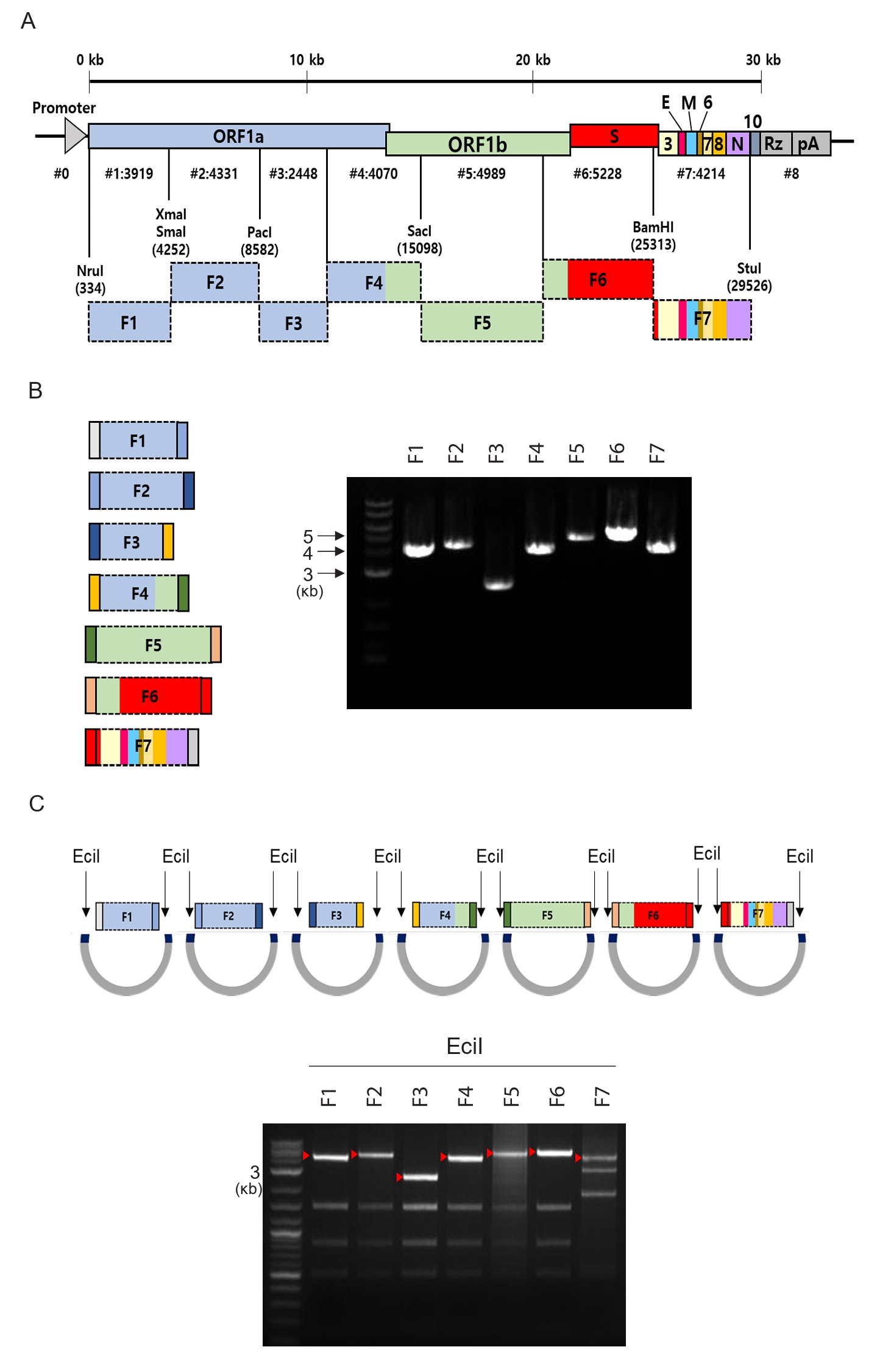
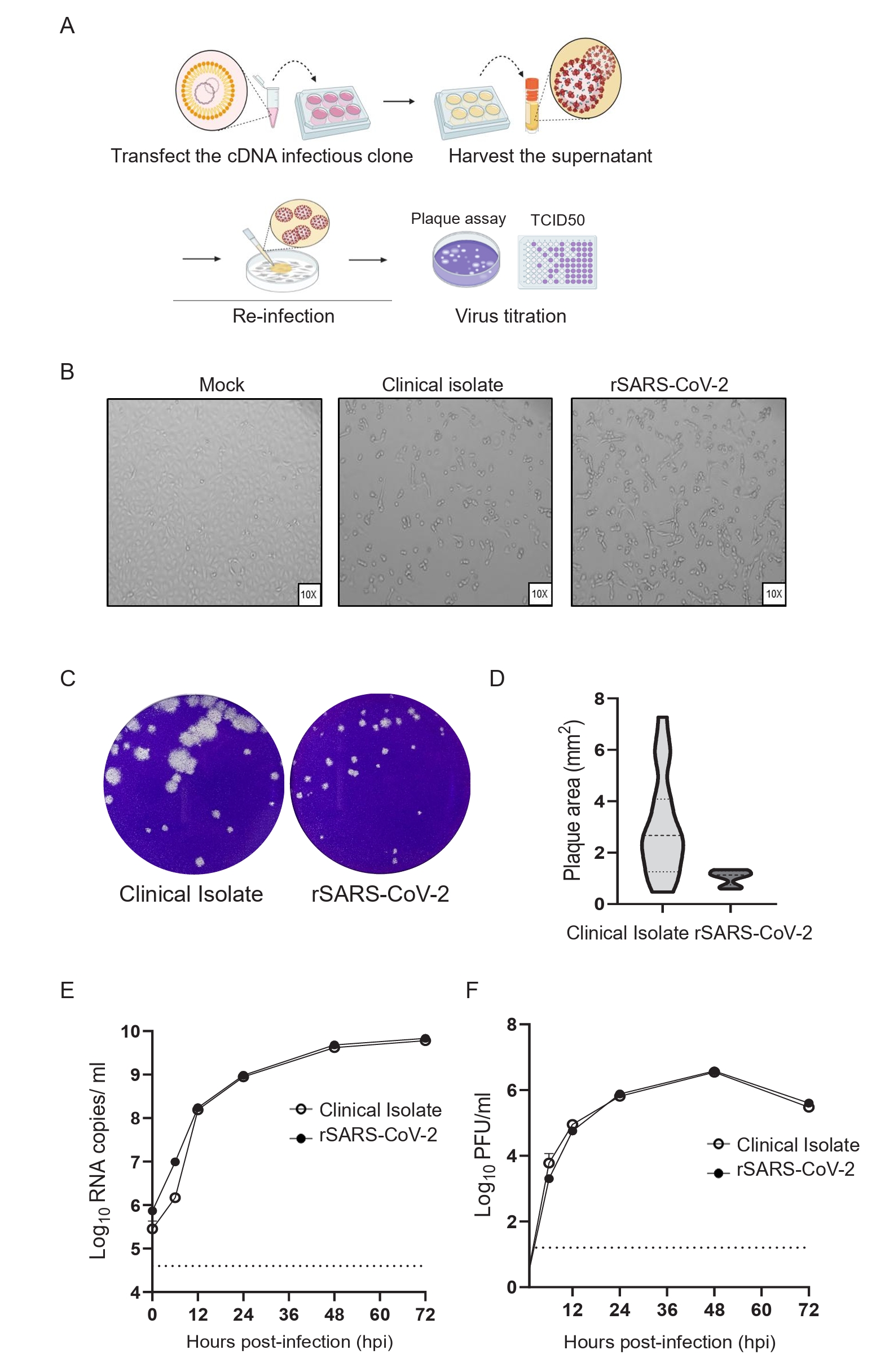
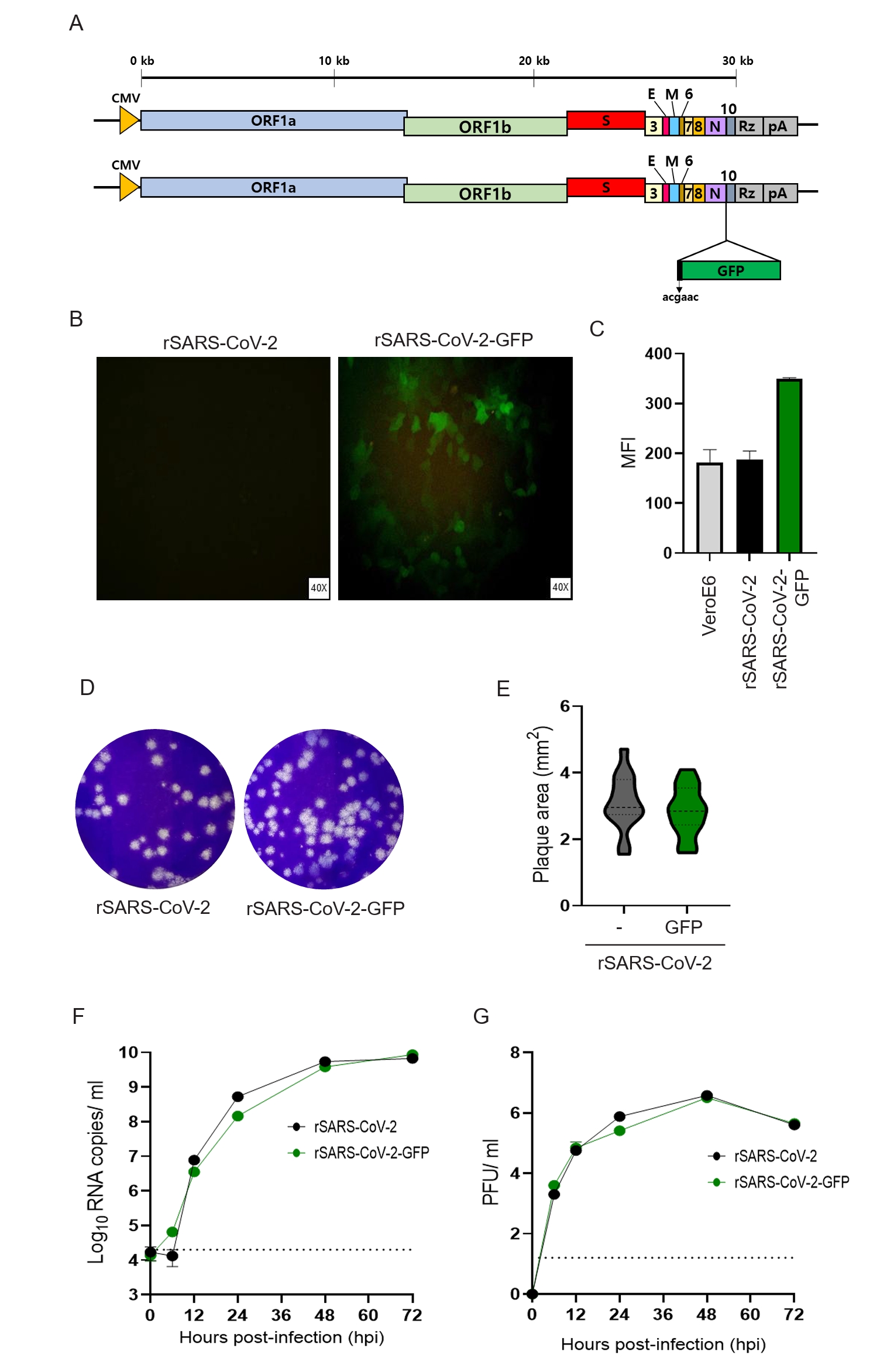
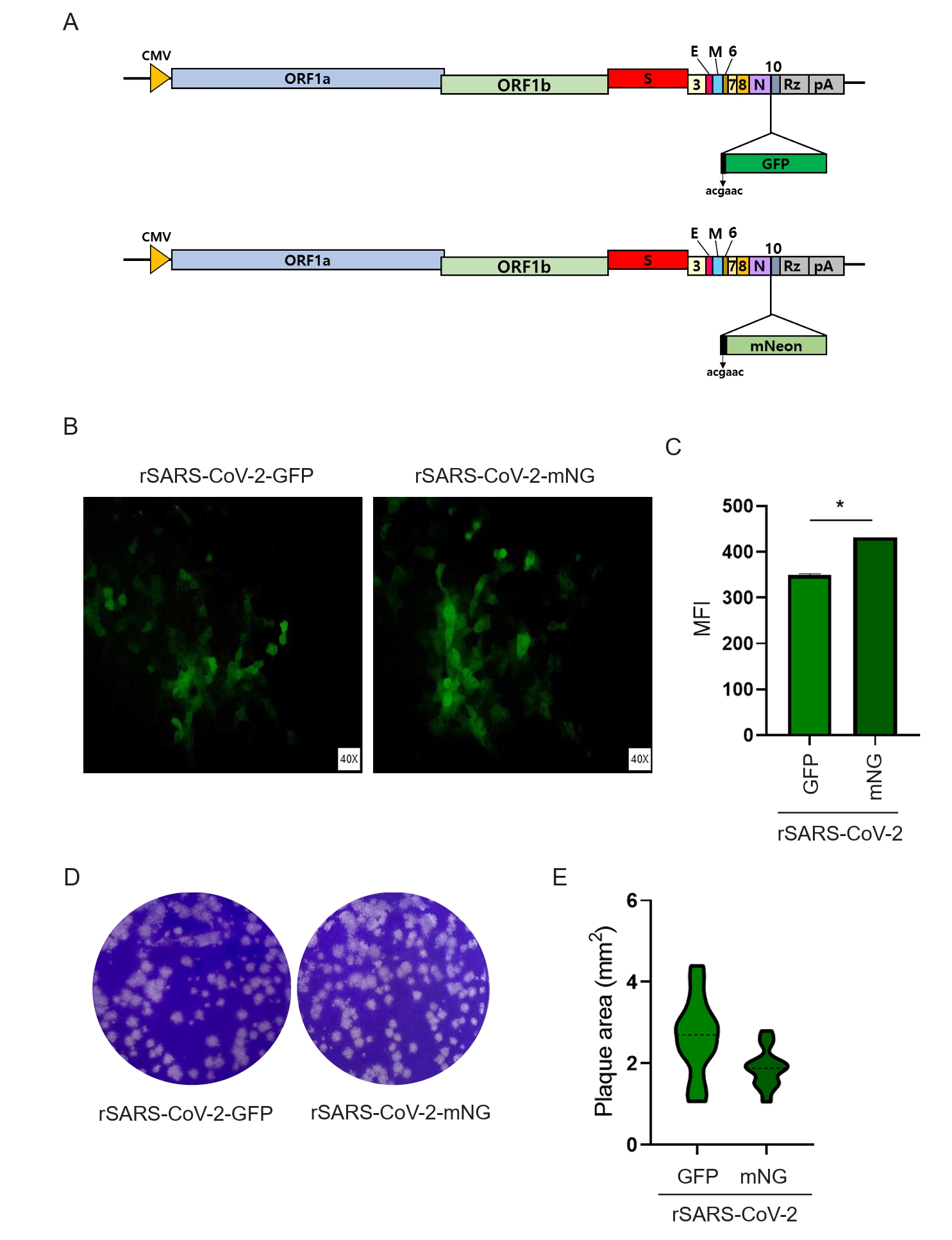
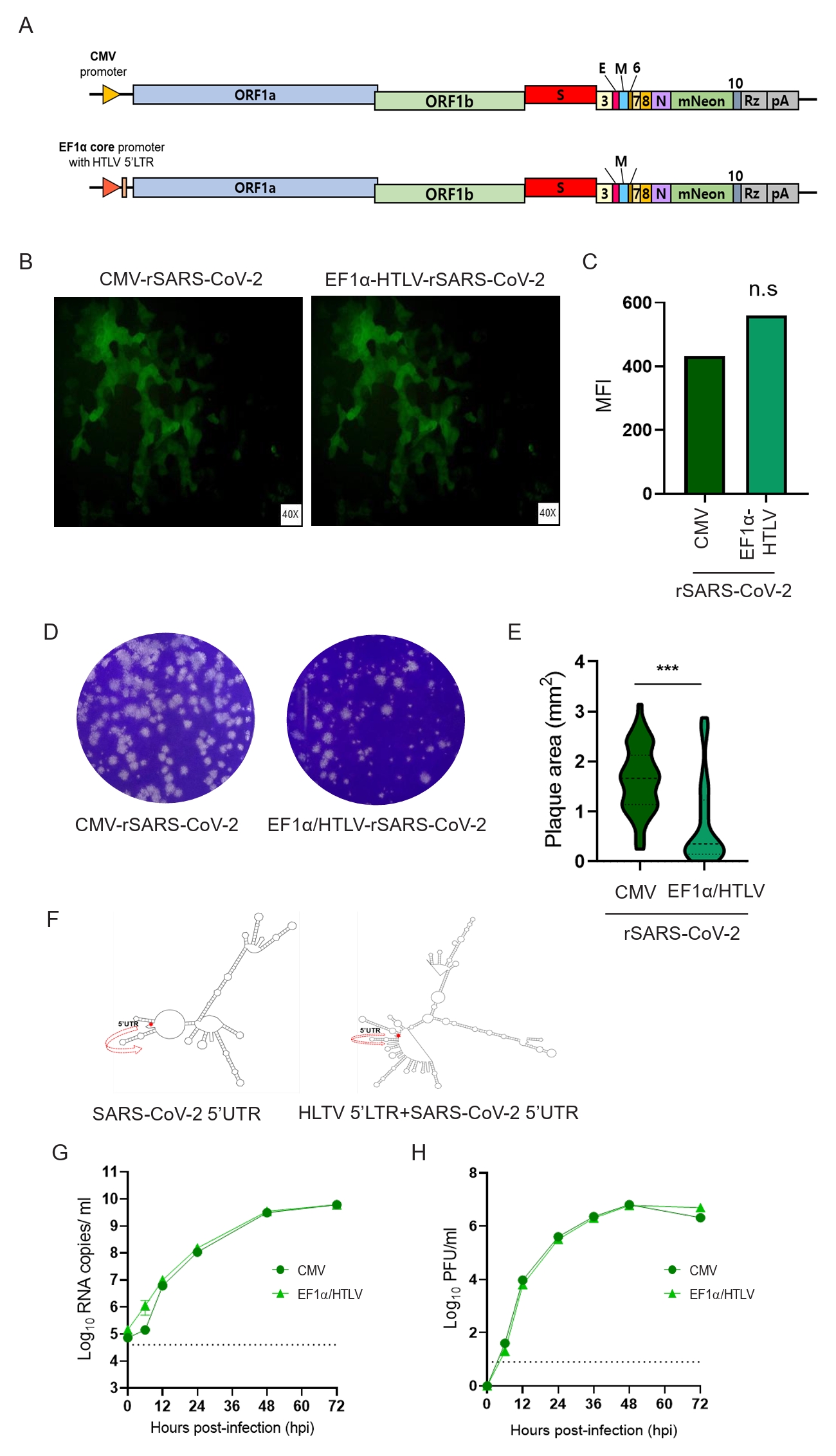
- Acosta AM, Garg S, Pham H, Whitaker M, Anglin O, et al. 2021. Racial and ethnic disparities in rates of COVID-19-associated hospitalization, intensive care unit admission, and in-hospital death in the United States from March 2020 to February 2021. JAMA Netw Open. 4: e2130479. ArticlePubMedPMC
- Althouse BM, Wenger EA, Miller JC, Scarpino SV, Allard A, et al. 2020. Superspreading events in the transmission dynamics of SARS-CoV-2: opportunities for interventions and control. PLoS Biol. 18: e3000897. ArticlePubMedPMC
- Amarilla AA, Sng JDJ, Parry R, Deerain JM, Potter JR, et al. 2021. A versatile reverse genetics platform for SARS-CoV-2 and other positive-strand RNA viruses. Nat Commun. 12: 3431.ArticlePubMedPMCPDF
- Baden LR, El Sahly HM, Essink B, Kotloff K, Frey S, et al. 2021. Efficacy and safety of the mRNA-1273 SARS-CoV-2 vaccine. N Engl J Med. 384: 403–416. ArticlePubMed
- Bae S, Lee JY, Myoung J. 2020. Chikungunya virus nsP2 impairs MDA5/RIG-I-mediated induction of NF-κB promoter activation: a potential target for virus-specific therapeutics. J Microbiol Biotechnol. 30: 1801–1809. ArticlePubMedPMC
- Beigel JH, Tomashek KM, Dodd LE, Mehta AK, Zingman BS, et al. 2020. Remdesivir for the treatment of Covid-19 - final report. N Engl J Med. 383: 1813–1826. ArticlePubMed
- Calder LJ, Calcraft T, Hussain S, Harvey R, Rosenthal PB. 2022. Electron cryotomography of SARS-CoV-2 virions reveals cylinder-shaped particles with a double layer RNP assembly. Commun Biol. 5: 1210.ArticlePubMedPMCPDF
- Chakraborty C, Bhattacharya M, Islam MA, Zayed H, Ohimain EI, et al. 2024. Reverse zoonotic transmission of SARS-CoV-2 and monkeypox virus: a comprehensive review. J Microbiol. 62: 337–354. ArticlePubMedPDF
- Chiem K, Morales Vasquez D, Park JG, Platt RN, Anderson T, et al. 2021. Generation and characterization of recombinant SARS-CoV-2 expressing reporter genes. J Virol. 95: e02209–20. ArticlePubMedPMCPDF
- Cho SY, Lee YJ, Jung SM, Son YM, Shin CG, et al. 2024. Establishment of a dual-vector system for gene delivery utilizing prototype foamy virus. J Microbiol Biotechnol. 34: 804–811. ArticlePubMedPMC
- Corbett KS, Edwards DK, Leist SR, Abiona OM, Boyoglu-Barnum S, et al. 2020. SARS-CoV-2 mRNA vaccine design enabled by prototype pathogen preparedness. Nature. 586: 567–571. ArticlePubMedPMC
- Fahnøe U, Pham LV, Fernandez-Antunez C, Costa R, Rivera-Rangel LR, et al. 2022. Versatile SARS-CoV-2 reverse-genetics systems for the study of antiviral resistance and replication. Viruses. 14: 172.ArticlePubMedPMC
- García-Arriaza J, Garaigorta U, Pérez P, Lázaro-Frías A, Zamora C, et al. 2021. COVID-19 vaccine candidates based on modified vaccinia virus Ankara expressing the SARS-CoV-2 spike induce robust T- and B-cell immune responses and full efficacy in mice. J Virol. 95: jvi.02260-20.ArticlePubMedPMC
- Goel RR, Painter MM, Apostolidis SA, Mathew D, Meng W, et al. 2021. mRNA vaccines induce durable immune memory to SARS-CoV-2 and variants of concern. Science. 374: abm0829.ArticlePubMedPMC
- Gottlieb RL, Vaca CE, Paredes R, Mera J, Webb BJ, et al. 2022. Early remdesivir to prevent progression to severe Covid-19 in outpatients. N Engl J Med. 386: 305–315. ArticlePubMedPMC
- Hou YJ, Okuda K, Edwards CE, Martinez DR, Asakura T, et al. 2020. SARS-CoV-2 reverse genetics reveals a variable infection gradient in the respiratory tract. Cell. 182: 429–446. ArticlePubMedPMC
- Hu B, Guo H, Zhou P, Shi ZL. 2021. Characteristics of SARS-CoV-2 and COVID-19. Nat Rev Microbiol. 19: 141–154. ArticlePubMedPMCPDF
- Islam MN, Lee KW, Yim HS, Lee SH, Jung HC, et al. 2017. Optimizing T4 DNA polymerase conditions enhances the efficiency of one-step sequence- and ligation-independent cloning. Biotechniques. 63: 125–130. ArticlePubMed
- Jackson LA, Anderson EJ, Rouphael NG, Roberts PC, Makhene M, et al. 2020. An mRNA vaccine against SARS-CoV-2 - preliminary report. N Engl J Med. 383: 1920–1931. ArticlePubMed
- Jamison DA Jr, Anand Narayanan S, Trovao NS, Guarnieri JW, Topper MJ, et al. 2022. A comprehensive SARS-CoV-2 and COVID-19 review, part 1: Intracellular overdrive for SARS-CoV-2 infection. Eur J Hum Genet. 30: 889–898. ArticlePubMedPMCPDF
- Jeong JY, Yim HS, Ryu JY, Lee HS, Lee JH, et al. 2012. One-step sequence- and ligation-independent cloning as a rapid and versatile cloning method for functional genomics studies. Appl Environ Microbiol. 78: 5440–5443. ArticlePubMedPMCPDF
- Kevadiya BD, Machhi J, Herskovitz J, Oleynikov MD, Blomberg WR, et al. 2021. Diagnostics for SARS-CoV-2 infections. Nat Mater. 20: 593–605. ArticlePubMedPMCPDF
- Kim TH, Bae S, Goo S, Myoung J. 2023. Distinctive combinations of RBD mutations contribute to antibody evasion in the case of the SARS-CoV-2 beta variant. J Microbiol Biotechnol. 33: 1587–1594. ArticlePubMedPMC
- Kim TH, Bae S, Myoung J. 2024a. Differential impact of spike protein mutations on SARS-CoV-2 infectivity and immune evasion: Insights from Delta and Kappa variants. J Microbiol Biotechnol. 34: 2506–2515. ArticlePubMedPMC
- Kim WJ, Lee AR, Hong SY, Kim SH, Kim JD, et al. 2024b. Characterization of a small plaque variant derived from genotype V Japanese encephalitis virus clinical isolate K15P38. J Microbiol Biotechnol. 34: 1592–1598. ArticlePubMedPMC
- Lee SC, Kim Y, Cha JW, Chathuranga K, Dodantenna N, et al. 2024. CA-CAS-01-A: A permissive cell line for isolation and live attenuated vaccine development against African swine fever virus. J Microbiol. 62: 125–134. ArticlePubMedPMCPDF
- Lee SY, Lee J, Park HL, Park YW, Kim H, et al. 2023. The adenylyl cyclase activator forskolin increases influenza virus propagation in MDCK cells by regulating ERK1/2 activity. J Microbiol Biotechnol. 33: 1576–1586. ArticlePubMedPMC
- Lee JY, Nguyen TTN, Myoung J. 2020. Zika virus-encoded NS2A and NS4A strongly downregulate NF-κB promoter activity. J Microbiol Biotechnol. 30: 1651–1658. ArticlePubMedPMC
- Li G, Hilgenfeld R, Whitley R, De Clercq E. 2023. Therapeutic strategies for COVID-19: Progress and lessons learned. Nat Rev Drug Discov. 22: 449–475. ArticlePubMedPMCPDF
- Liu R, Han H, Liu F, Lv Z, Wu K, et al. 2020. Positive rate of RT-PCR detection of SARS-CoV-2 infection in 4880 cases from one hospital in Wuhan, China, from Jan to Feb 2020. Clin Chim Acta. 505: 172–175. ArticlePubMedPMC
- Liu Y, Zhang X, Liu J, Xia H, Zou J, et al. 2022. A live-attenuated SARS-CoV-2 vaccine candidate with accessory protein deletions. Nat Commun. 13: 4337.ArticlePubMedPMCPDF
- Lu R, Zhao X, Li J, Niu P, Yang B, et al. 2020. Genomic characterisation and epidemiology of 2019 novel coronavirus: implications for virus origins and receptor binding. Lancet. 395: 565–574. ArticlePubMedPMC
- Mattoo SS, Myoung J. 2021. A promising vaccination strategy against COVID-19 on the horizon: heterologous immunization. J Microbiol Biotechnol. 31: 1601–1614. ArticlePubMedPMC
- Moon JS, Lee W, Cho YH, Kim Y, Kim GW. 2024. The significance of N6-methyladenosine RNA methylation in regulating the hepatitis B virus life cycle. J Microbiol Biotechnol. 34: 233–239. ArticlePubMedPMC
- Myoung J. 2022. Two years of COVID-19 pandemic: Where are we now? J Microbiol. 60: 235–237. ArticlePubMedPMCPDF
- Nakano K, Watanabe T. 2012. HTLV-1 Rex: The courier of viral messages making use of the host vehicle. Front Microbiol. 3: 330.ArticlePubMedPMC
- Nakano K, Watanabe T. 2022. Tuning Rex rules HTLV-1 pathogenesis. Front Immunol. 13: 959962.ArticlePubMedPMC
- Nam J, Lee J, Kim GA, Yoo SM, Park C, et al. 2024. Infection dynamics of dengue virus in Caco-2 cells depending on its differentiation status. J Microbiol. 62: 799–809. ArticlePubMedPDF
- Nie Y, Deng D, Mou L, Long Q, Chen J, et al. 2023. Dengue virus 2 NS2B targets MAVS and IKKε to evade the antiviral innate immune response. J Microbiol Biotechnol. 33: 600–606. ArticlePubMedPMC
- Nouailles G, Adler JM, Pennitz P, Peidli S, Teixeira Alves LG, et al. 2023. Live-attenuated vaccine sCPD9 elicits superior mucosal and systemic immunity to SARS-CoV-2 variants in hamsters. Nat Microbiol. 8: 860–874. ArticlePubMedPMCPDF
- Park SC, Jeong DE, Han SW, Chae JS, Lee JY, et al. 2024. Vaccine development for severe fever with thrombocytopenia syndrome virus in dogs. J Microbiol. 62: 327–335. ArticlePubMedPDF
- Patel R, Kaki M, Potluri VS, Kahar P, Khanna D. 2022. A comprehensive review of SARS-CoV-2 vaccines: Pfizer, Moderna & Johnson & Johnson. Hum Vaccin Immunother. 18: 2002083.ArticlePubMedPMC
- Polack FP, Thomas SJ, Kitchin N, Absalon J, Gurtman A, et al. 2020. Safety and efficacy of the BNT162b2 mRNA COVID-19 vaccine. N Engl J Med. 383: 2603–2615. ArticlePubMed
- Raharinirina NA, Gubela N, Bornigen D, Smith MR, Oh DY, et al. 2025. SARS-CoV-2 evolution on a dynamic immune landscape. Nature. 639: 196–204. ArticlePubMedPMCPDF
- Sachs JD, Karim SSA, Aknin L, Allen J, Brosbøl K, et al. 2022. The Lancet Commission on lessons for the future from the COVID-19 pandemic. Lancet. 400: 1224–1280. ArticlePubMedPMC
- Saha S, Bhattacharya M, Lee SS, Chakraborty C. 2024. Recent advances of nipah virus disease: Pathobiology to treatment and vaccine advancement. J Microbiol. 62: 811–828. ArticlePubMedPDF
- Schon J, Barut GT, Trueb BS, Halwe NJ, Berenguer Veiga I, et al. 2024. A safe, effective and adaptable live-attenuated SARS-CoV-2 vaccine to reduce disease and transmission using one-to-stop genome modifications. Nat Microbiol. 9: 2099–2112. ArticlePubMedPMCPDF
- Shaner NC, Lambert GG, Chammas A, Ni Y, Cranfill PJ, et al. 2013. A bright monomeric green fluorescent protein derived from Branchiostoma lanceolatum. Nat Methods. 10: 407–409. ArticlePubMedPMCPDF
- Stokes AC, Lundberg DJ, Elo IT, Hempstead K, Bor J, et al. 2021. COVID-19 and excess mortality in the United States: a county-level analysis. PLoS Med. 18: e1003571. ArticlePubMedPMC
- Stowe J, Andrews N, Kirsebom F, Ramsay M, Bernal JL. 2022. Effectiveness of COVID-19 vaccines against Omicron and Delta hospitalisation, a test negative case-control study. Nat Commun. 13: 5736.ArticlePubMedPMCPDF
- Suzuki Okutani M, Okamura S, Gis T, Sasaki H, Lee S, et al. 2025. Immunogenicity and safety of a live-attenuated SARS-CoV-2 vaccine candidate based on multiple attenuation mechanisms. Elife. 13: RP97532.ArticlePubMedPMC
- Thi Nhu Thao T, Labroussaa F, Ebert N, V'Kovski P, Stalder H, et al. 2020. Rapid reconstruction of SARS-CoV-2 using a synthetic genomics platform. Nature. 582: 561–565. ArticlePubMedPDF
- Thomas SJ, Moreira ED Jr, Kitchin N, Absalon J, Gurtman A, et al. 2021. Safety and efficacy of the BNT162b2 mRNA COVID-19 vaccine through 6 months. N Engl J Med. 385: 1761–1773. ArticlePubMed
- Toussi SS, Hammond JL, Gerstenberger BS, Anderson AS. 2023. Therapeutics for COVID-19. Nat Microbiol. 8: 771–786. ArticlePubMedPDF
- Trimpert J, Dietert K, Firsching TC, Ebert N, Thi Nhu Thao T, et al. 2021. Development of safe and highly protective live-attenuated SARS-CoV-2 vaccine candidates by genome recoding. Cell Rep. 36: 109493.ArticlePubMedPMC
- Turner JS, O'Halloran JA, Kalaidina E, Kim W, Schmitzet AJ, et al. 2021. SARS-CoV-2 mRNA vaccines induce persistent human germinal centre responses. Nature. 596: 109–113. ArticlePubMedPMCPDF
- Walls AC, Park YJ, Tortorici MA, Wall A, McGuire AT, et al. 2020. Structure, function, and antigenicity of the SARS-CoV-2 spike glycoprotein. Cell. 181: 281–292. ArticlePubMedPMC
- Wang W, Peng X, Jin Y, Pan JA, Guo D. 2022. Reverse genetics systems for SARS-CoV-2. J Med Virol. 94: 3017–3031. ArticlePubMedPMCPDF
- Wang Q, Zhang Y, Wu L, Zhou H, Yan J, et al. 2020. Structural and functional basis of SARS-CoV-2 entry by using human ACE2. Cell. 181: 894–904. ArticlePubMedPMC
- Worobey M, Levy JI, Malpica Serrano L, Crits-Christoph A, Pekar JE, et al. 2022. The Huanan Seafood Wholesale Market in Wuhan was the early epicenter of the COVID-19 pandemic. Science. 377: 951–959. ArticlePubMedPMC
- Xie X, Lokugamage KG, Zhang X, Vu MN, Muruato AE, et al. 2021. Engineering SARS-CoV-2 using a reverse genetic system. Nat Protoc. 16: 1761–1784. ArticlePubMedPMCPDF
- Ye C, Chiem K, Park JG, Oladunni F, Platt RN 2nd, et al. 2020. Rescue of SARS-CoV-2 from a single bacterial artificial chromosome. mBio. 11: e02168–20. ArticlePubMedPMCPDF
- Ye C, Chiem K, Park JG, Silvas JA, Morales Vasquez D, et al. 2021. Analysis of SARS-CoV-2 infection dynamic in vivo using reporter-expressing viruses. Proc Natl Acad Sci USA. 118: e2111593118. ArticlePubMedPMC
- Ye C, Martinez-Sobrido L. 2022. Use of a bacterial artificial chromosome to generate recombinant SARS-CoV-2 expressing robust levels of reporter genes. Microbiol Spectr. 10: e0273222. ArticlePubMedPMCPDF
- Ye C, Park JG, Chiem K, Dravid P, Allue-Guardia A, et al. 2023. Immunization with recombinant accessory protein-deficient SARS-CoV-2 protects against lethal challenge and viral transmission. Microbiol Spectr. 11: e0065323.ArticlePubMedPMCPDF
- Zhu J, Wang Z, Li Y, Zhang Z, Ren S, et al. 2024. Trimerized S expressed by modified vaccinia virus Ankara (MVA) confers superior protection against lethal SARS-CoV-2 challenge in mice. J Virol. 98: e0052124. ArticlePubMedPMCPDF
- Zuker M. 2003. Mfold web server for nucleic acid folding and hybridization prediction. Nucleic Acids Res. 31: 3406–3415. ArticlePubMedPMC
References
Figure & Data
References
Citations






Fig. 1.
Fig. 2.
Fig. 3.
Fig. 4.
Fig. 5.
| Primer information | ||
|---|---|---|
| PCR Primer sequence | ||
| Forward primer | Reverse primer | |
| F1 | 5'-cacacgtccaactcagtttgcctgttttacaggttcgcga-3' | 5'-ccatttaaaccctgacccgggtaagtg-3' |
| F2 | 5'-cagacaattatataaccacttacccgggtc-3' | 5'-ggaacacaagtgtaactttaattaactgcttc-3' |
| F3 | 5'-gttaataattggttgaagcagttaattaaagttacacttgtgttcc-3' | 5'-ggactaaaactaaaagtgaagtcaaaattgtgag-3' |
| F4 | 5'-gttactcacaattttgacttcacttttagttttagtcc-3' | 5'-caccagctacggtgcgagctctattc-3' |
| F5 | 5'-cattagtgcaaagaatagagctcgcacc-3' | 5'-ccattaagactagcttgtttgggacctacag-3' |
| F6 | 5'-ggtttacaaccatctgtaggtcccaaacaag-3' | 5'-gtcttcatcaaatttgcagcaggatccac-3' |
| F7 | 5'-ctcaagggctgttgttcttgtggatcc-3' | 5'-cgtttatatagcccatctgccttgtgtgg-3' |
| Primer information | ||
|---|---|---|
| PCR Primer sequence | ||
| Forward primer | Reverse primer | |
| F1 | 5'-ggatccGGCGGAtaccagtgtgtttgcctgttttacaggttcgcgacgtgctcgtac-3' | 5'-ctcgagGGCGGAtaccagtgtccatttaaaccctgacccgggtaagtggttatataattgtc-3' |
| F2 | 5'-ggatccGGCGGAtaccagtgtttatataaccacttacccgggtcagggtttaaatg-3' | 5'-ctcgagGGCGGAtaccagtgtcacaagtgtaactttaattaactgcttcaaccaattattaacaattttacc-3' |
| F3 | 5'-ggatccGGCGGAtaccagtgtaattggttgaagcagttaattaaagttacacttgtgttcctttttg-3' | 5'-ctcgagGGCGGAtaccagtgtctaaaactaaaagtgaagtcaaaattgtgagtaacaaccag-3' |
| F4 | 5'-ggatccGGCGGAtaccagtgtgttactcacaattttgacttcacttttagttttagtccagagtac-3' | 5'-ctcgagGGCGGAtaccagtgtcaccagctacggtgcgagctctattctttgcactaatggc-3' |
| F5 | 5'-ggatccGGCGGAtaccagtgtttagtgcaaagaatagagctcgcaccgtagctg-3' | 5'-ctcgagGGCGGAtaccagtgtaagactagcttgtttgggacctacagatggttgtaaacc-3' |
| F6 | 5'-tctagaGGCGGAtaccagtgtttacaaccatctgtaggtcccaaacaagctagtcttaatg-3' | 5'-ctcgagGGCGGAtaccagtgtatcaaatttgcagcaggatccacaagaacaacagccc-3' |
| F7 | 5'-cctgcaggGGCGGAtaccagtgtggctgttgttcttgtggatcctgctgcaaatttgatgaaga-3' | 5'-gggcccGGCGGAtaccagtgtggtctgcatgagtttaggcctgagttgagtcagcac-3' |
| Primer information | |
|---|---|
| PCR Primer sequence | |
| CMVp-nCoV-0-vec-linear-F | 5'- ccatgagcagtgctgactcaactcaggcctaaactcatgcagaccac -3' |
| CMVp-nCoV-0-vec-linear-R | 5'- gtctccaaagccacgtacgagcacgtcgcgaacctgtaaaacaggcaaac -3' |
| CMVp-Gibson-F | 5'- ggtccgggccattatggccacctggtggatctgcgatcgcgacattgattattgactagttattaatagtaatc -3' |
| CMVp-Gibson-R | 5'- gttggttggtttgttacctgggaaggtataaacctttaatagctctgcttatatagacctccc -3' |
| nCoV-0-Gibson-F | 5'- attaaaggtttataccttcccaggtaacaaac -3' |
| nCoV-0-Gibson-R | 5'- cttaattaagcgcgccccggggcgcgctcgcgaacctgtaaaacaggc -3' |
| Primer information | |
|---|---|
| PCR Primer sequence | |
| pMQ131-CMV-vec-linear-F | 5'- ggaggctaactgaaacacggaa -3' |
| pMQ131-CMV-vec-linear-R | 5'- agctctgcttatatagacctcccac -3' |
| SLIC-7a-TRS-GFP-F | 5'- tgctgactcaactcaggcctaaacgaacatggtgagcaagggcgag -3' |
| SLIC-7a-TRS-mNeonGreen-F | 5'- tgctgactcaactcaggcctaaacgaacatggtgagcaagggcgag -3' |
| SLIC-7a-TRS-GFP or mNeonGreen-R | 5'- ccagtgtggtctgcatgagttt -3' |
Table 1.
Table 2.
Table 3.
Table 4.
TOP
 MSK
MSK

 ePub Link
ePub Link Cite this Article
Cite this Article






